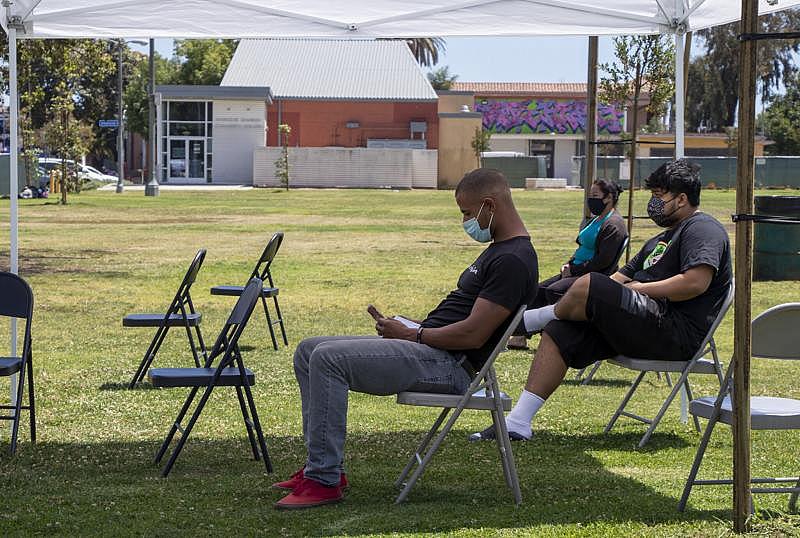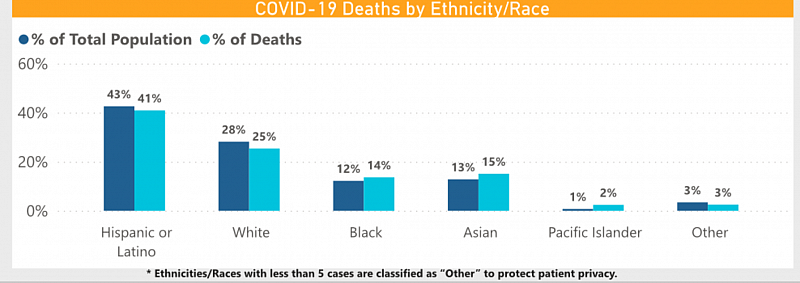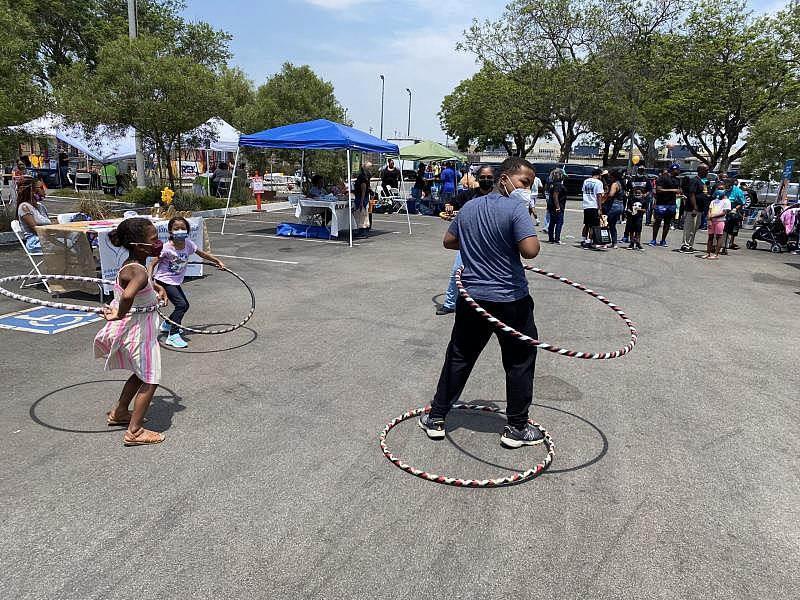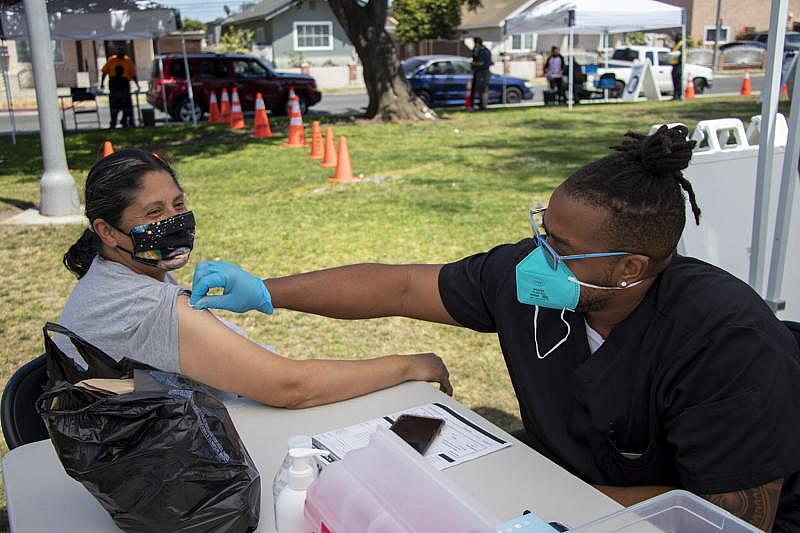Convincing the unvaccinated: City pushes to vaccinate vulnerable groups as COVID-19 delta variant rages
This article is the first of a larger project produced by Kellly Puente for the USC Annenberg Center for Health Journalism’s 2021 California Fellowship.
Her other stories include:
Part 2: ‘A sad wake up call’: COVID-19 has hit Pacific Islanders harder than any other group

A woman receives a COVID-19 vaccine during a mobile vaccine clinic at the rear of MacArthur Park in Central Long Beach on Tuesday, May 25, 2021.
Photo by Crystal Niebla.
Alicia Coulter was working at a COVID-19 health resources fair for the Black community in Long Beach this summer when a nervous 15-year-old girl approached her booth.
Freshly vaccinated individuals sit for about 15 minutes after receiving a one-dose during a mobile vaccine clinic at the rear of MacArthur Park in Central Long Beach on Tuesday, May 25, 2021. Photo by Crystal Niebla.
“Put your head up!” Coulter told the girl. “You’re saving your life.”
Coulter is one of many health workers fighting to convince more people to get vaccinated as COVID-19 cases surge across the country, fueled by the highly-contagious delta variant.
In Long Beach, health officials say they’ve made progress in getting new people vaccinated in recent weeks with a nearly 50% increase, from an average of 357 to 527 doses a day. At the beginning of this month, more than 73% of the city’s adult population was vaccinated.
But as a dense and diverse urban city with a high number of younger people, and Black and Latino residents, Long Beach faces additional challenges in reaching those groups who are statistically less likely to get vaccinated.
That’s where grassroots workers like Coulter can help. As head of Advantage Health Now, a Long Beach nonprofit that focuses on health equity for Black and Brown communities, Coulter said community groups are key for convincing the hard to convince.
For example, in a recent webinar on COVID-19 in the Black community, the group brought in an expert from Morehouse College, a renowned historically Black college in Atlanta.
“They’re hearing from people who have the academic wherewithal but they physically look like them and they speak the tone using the Ebonics,” she said. “It’s about having the ability to speak the language. We’re another tool in the city’s arsenal.”
And with COVID-19 rates once again surging, the city will need every tool in its arsenal.
Pushing to save lives
At the beginning of the vaccine rollout this year, Long Beach saw significant disparities as shots went mostly to White residents in wealthier areas, compared to low-income neighborhoods with higher COVID-19 rates.
City officials said the disparity was largely due to the fact that people over 65 were prioritized early, and those residents tend to live in wealthier, Whiter parts of the city.
Source: City of Long Beach
Latinos make up the city’s largest adult population at 38%, but they account for 30% of vaccinations, according to city data for early August. White residents, on the other hand, make up 32% of the adult population but account for 31% of vaccinations, while Black residents make up 13% of the population and 8% of vaccinations.
And as the delta variant rages, health workers say it’s more urgent than ever to reach unvaccinated Black and Latino residents as they’re statistically more likely to be hospitalized and die from the virus.
“We know COVID has disproportionately affected the Black community in Long Beach and all around the U.S.,” said Amber Johnson, a health science professor at Cal State Long Beach who works with the city’s Black Health Equity team. “And it’s unveiled a lot of the long-standing disparities, not just in the difference between rates of diseases among Black people compared to other communities, but also the inequities in regards to access to healthcare.”
COVID-19 death rates by ethnicity/race in Long Beach. Source: City of Long Beach
The pandemic has even disproportionately affected life expectancy rates for Black and Latino Americans. A federal report released last month shows that overall life expectancy in 2020 fell to the lowest numbers since 2003, in a decline largely attributed to the more than 600,000 COVID-19 deaths. The Latino population saw the largest decline, from 81.8 to 78.8 years, while life expectancy for the Black population dropped from 74.7 to 71.8 years. Life expectancy for White Americans dropped from 78.8 to 77.6 years.
Latinos have an overall higher life expectancy than the white population, but that gap narrowed in the pandemic, the report noted.
Long Beach’s other communities of color have also been hit disproportionately by COVID-19.
The city is home to one of largest Cambodian communities outside of Cambodia, and residents say they’ve struggled with government mistrust and wariness from older immigrants who survived the country’s genocide under the Khmer Rouge dictatorship.
“There’s a lot of misinformation circling,” 6th District Councilwoman Suely Saro told the Post last year.
The city has worked to reach Cambodian residents with town hall meetings in Khmer and partnerships with community organizations.
But adding to the concern, Cambodians have said they should be counted separately from the city’s “Asian” group since they may be disproportionately affected compared to other Asians. Without the data, it’s hard to know how the city’s Cambodians are uniquely impacted.
Long Beach’s large Pacific Islander community, especially its Samoan community, was hit hard by the pandemic. The group this year saw the highest death rate out of any group in Los Angeles County and Long Beach.
City numbers earlier this year showed that Pacific Islanders were nine times more likely to be hospitalized and seven times more likely to die compared to White residents.
But Pacific Islanders have since seen higher vaccination rates compared to other groups, thanks in part to organizations like Empowering Pacific Islander Communities (EPIC).
Long Beach resident Kymberli Jenkins, 25, received her first shot of the coronavirus vaccine at Houghton Park on Saturday, July 24, 2021. Photo by Alena Maschke
Hospital rates, meanwhile, have once again spiked as the delta variant hits the community.
In the first week in August, there were 99 COVID-19 patients in local hospitals. It’s a jump from early June when the number hovered around 10, but it’s significantly lower than the peak of almost 600 local hospitalizations in the winter surge in January.
With the vaccine now widely available, health workers are shifting their approach for hard to reach groups, especially younger people.
And in some cases, they’re getting creative.
Last month, the Healthy Long Beach campaign held a “Joints for Jabs” event where adults over 21 who received a vaccine got a token for a free, pre-rolled cannabis cigarette. City workers at the event said more than dozen people got shots that day, in exchange for joint vouchers or even popsicles.
But experts say health workers will have to address long-standing health disparities and the different concerns in communities of color if they hope to convince groups who are wary of side effects or distrusting of the government for various reasons.
A focus on Black health
Emmanuella Ugbah, 35, has yet to be vaccinated, but on a recent Saturday she visited a Black Health Fair in Houghton Park in North Long Beach to get more information.
Ugbah, who’s originally from Nigeria, said she doesn’t want to get sick from COVID-19 as a mom with two young children, but she’s also worried about the vaccine’s long-term effects.
“I hear people have gotten sick after the vaccine,” she said. “I just want to give it more time.”
Kids play with hula hoops at a Black Health Fair in North Long Beach on July 24. Photo by Kelly Puente.
Coulter said many Black Americans are hesitant to get the vaccine because of lingering mistrust in the medical system. While some site the infamous Tuskegee study in which the government left more than 600 Black men with untreated syphilis, Coulter said it’s more about historic racism in health care.
She cited studies in on racial bias in pain assessment and treatment for Black people and an overall lack of access to equal medical care.
“They don’t even have to go back as far as Tuskegee,” she said. “They can go back to two months ago by the way their grandmother was treated in the hospital, or the way they were treated in the hospital.”
The first step in reaching those who are wary of the medical system is to affirm and validate their concerns, she said.
“First off we tell them, ‘Full stop. We know you do not trust the system and you are correct in that’,” she said.
Nelson Williams, a 62-year-old former Navy serviceman, said he’s not necessarily mistrustful of the government, but has opted not to get the vaccine because of concerns about the long-term effects.
“I can see why people feel that way but that’s not my reasoning,” he said. “I’ve done my research and looked at the science and believe this is the best decision for me. No one knows how this will impact us years down the line.”
Williams, who works in imaging at the Long Beach VA Hospital, said he believes everyone should make their own decision. His wife and daughter, who are both healthcare workers, got the jab.
Williams said he lost 40 pounds last year after he was diagnosed with diabetes. He said he believes he can stave off the virus by working out and eating a healthy diet of fruits and vegetables.
“I’ll keep wearing my mask,” he said.
Erica Ashley, an intensive care unit nurse, said she’s heard many reasons for not getting the vaccine from the unvaccinated who end up in her hospital for COVID-19 complications. Ashley is part of a group of nurses who travel around the Southland to Black churches, parks and other spaces to educate people on the importance of the vaccine.
“You have to meet people where they’re at,” she said. “Because the hardest thing is seeing people die when they don’t have to die.”
For some groups, it can be a mix of mistrust combined with life’s circumstances.
Reaching the Latino community
At a community block party last month in one of Long Beach’s most COVID-impacted neighborhoods, Cristal—who only identified herself by her first name—was at a mobile pop-up clinic to get one of her family members a second dose of the vaccine.
Cristal, 29, was concerned for her older family member, but she herself is not vaccinated because she’s concerned about missing work from the potential side effects. Some of her friends who took the jab, she said, were bedridden, feeling sick and unable to work.
As a Long Beach restaurant worker with two young daughters, she can’t afford to miss days of work.
“Where I work, if I miss, they don’t pay me,” she said. “If I’m off for, let’s say, a week, that’s a week that I don’t get paid. I don’t live bad, but I depend on the check, too.”
Cristal said she will wait until her workplace deems it mandatory to have the vaccine. She’s like many others in the dense Washington neighborhood who depend on every dollar they earn. Set in Long Beach’s inner city, the Washington neighborhood has a high poverty rate and high number of Latino immigrants. The area also has had one of the city’s highest COVID-19 numbers and lowest vaccine rates.
Jesus Esparza, a community organizer and leader in the Washington neighborhood, said some of his neighbors were hesitant to get the vaccine because they’ve also heard of side effects that could mean days off work.
Esparza said many of his neighbors work in Long Beach packaging warehouses.
“Lots of us are living day-to-day,” he said in Spanish. “If you don’t work today, you don’t eat tomorrow. It sounds ugly, but it’s true.”
Darren Grant, right, prepares the arm of 58-year-old Rosa Sandoval, left, for a COVID-19 vaccine during a mobile vaccine clinic at MacArthur Park in Central Long Beach on Tuesday, May 25, 2021. Photo by Crystal Niebla.
Dr. Jorge Caballero, a former anesthesiologist at Stanford Medical Center who follows data on the delta variant, has heard many reasons as to why people choose to not get vaccinated.
While some are absurd, he said, missing work is a valid reason.
“These folks have legitimate concerns that are easy to address,” Caballero said. “One of those is the concern that the vaccine will cause symptoms that make it difficult to manage for a day or two and what that means in terms of being able to keep a roof over your head and keep food on the table—that is a valid concern.”
The hesitancy can double for undocumented Latinos, who are sometimes dissuaded by rumors that they need documentation to get the vaccine. Caballero said some vaccine sites may ask for medical insurance or an ID, but that’s optional.
Long Beach health officials have recruited the help of local nonprofits when language, cultural beliefs and immigration issues can be a barrier.
As of early May 2021, the organizations had contacted more than 27,200 families and 24,360 individuals through door-to-door canvassing, phone calls, texting, social media, in languages including English, Spanish, Khmer, Samoan and Tongan.
As a result of this focused effort, new doses for Latino residents grew the most, followed by Native Hawaiian/Pacific Islander and Black residents, according to a June city memo.
David Lowe, a public health specialist with the Long Beach Health and Human Services Department, said sometimes they’re successful in convincing someone to get vaccinated in their door-to-door efforts. Other times they reach a stalemate.
“We definitely don’t like to come across as vaccine police,” Lowe said. “Our job is just to inform the public about vaccines. When it comes to political stances, we’re neutral.”
Addressing health disparities
In one possible positive outcome, health experts say COVID-19 has sparked an overdue conversation on historic health inequities in communities of color, and how to address those problems moving forward.
Last year, Long Beach funded $1 million in COVID-19 relief aid to the city’s Black Health Equity program to support nonprofit groups and small business to reduce the pandemic’s impact on Black residents.
Johnson, with the Black Health Equity team, hopes the city will continue to fund the program to focus on health disparities beyond the pandemic.
“We’re trying to fight the good fight and the focus needs to be on what’s going to happen if we don’t have people like the Black Health Equity Collaborative out there serving the community,” she said.
As part of the effort, the city in November launched its first mental health program for Black residents, headed by clinical therapist Sandra Hardy.
Hardy said clients have come to her over the past year with fear, anxiety and concerns similar those of many Americans in the pandemic. But Black residents, she said, have the additional stress that comes with racism and the inequalities in health and income.
“It’s one more stressor that’s added to all the stressors of being Black in America,” she said.
As for the vaccine, Hardy said it’s not her job to offer her opinion or convince her clients, but she does provide the facts so they can make their own decision. And, she listens.
“We’ve been through so much,” she said. “But we also know how to rebound.”
Editor’s note: This article was produced as a project for the USC Annenberg Center for Health Journalism’s 2021 California Fellowship.
[This story was originally published by Long Beach Post News.]
Did you like this story? Your support means a lot! Your tax-deductible donation will advance our mission of supporting journalism as a catalyst for change.

